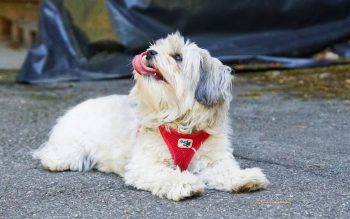The Havanese, with its cheerful nature and luxurious coat, is a beloved toy breed known for being both a companionable lap dog and a playful little clown. Though they may not require extensive exercise routines like larger breeds, Havanese dogs still benefit from regular physical and mental activity. This article will outline the appropriate types and amounts of exercise for a Havanese dog.
1. Assessing Havanese Exercise Requirements
Havanese dogs typically need a moderate amount of exercise—about 30 minutes per day. This can include short walks and playtime, tailored to their compact size and energy levels.
2. Understanding the Impact of Exercise on Havanese Health
Regular activity is important for Havanese to maintain a healthy weight, support cardiovascular health, and encourage proper joint function. Exercise also plays a key role in mental health, preventing anxiety and boredom.
3. Appropriate Types of Exercise for Havanese
Leisurely walks, moderate play sessions, and indoor games are ideal for this breed. Havanese also enjoy activities that stimulate their minds, such as learning new tricks or engaging with interactive toys.
4. The Role of Mental Stimulation in Exercise
Mental stimulation for Havanese can be just as tiring as physical exertion. Puzzle toys, scent games, and short but frequent training sessions will keep their intelligent minds engaged.
5. The Importance of Play in a Havanese’s Exercise Routine
Play is crucial for Havanese, not only for the physical exercise but also for their emotional well-being. They often enjoy playing with other friendly dogs or interactive play with their owners.
6. Tailoring Exercise to Your Havanese’s Life Stage
The exercise needs of Havanese puppies are different from adults. Puppies benefit from short bursts of play, while older dogs may require more sedate, longer activities to keep them mobile and active.
7. Adapting Exercise to Weather Conditions
Given their small size and susceptibility to cold, exercise routines for Havanese may need adjusting in colder climates, ensuring they are kept warm and comfortable.
8. Signs Your Havanese Is Receiving Adequate Exercise
A Havanese that is getting enough exercise will typically display a happy demeanor, have a good appetite, and sleep well. Lack of sufficient exercise can lead to signs of restlessness or weight gain.
9. Balancing Exercise with Relaxation
It’s important for Havanese to have a balance between activity and rest. Ensure they have a comfortable place to relax after exercise, as too much activity can be just as detrimental as too little.
10. Regular Health Checks and Exercise Adjustments
Regular veterinary check-ups will ensure that the exercise routine remains appropriate for your Havanese’s health and will help to identify any issues that may require adjustments to their activity levels.
Conclusion
Although they are a small breed, Havanese dogs still require and enjoy regular exercise. A combination of physical activities and mental challenges tailored to their size and energy level will ensure a healthy and happy life for your Havanese. Consult with a veterinarian to create an exercise plan that is appropriate for your dog’s individual needs.
Frequently Asked Questions About Exercising A Havanese
1. How much exercise does a Havanese need?
A Havanese typically needs about 30 minutes of exercise each day. This can be spread across the day with a couple of short walks and play sessions, as they have moderate energy levels suited for their small size.
2. What type of exercise is ideal for a Havanese?
Ideal exercises for a Havanese include leisurely walks, brief games of fetch, and gentle indoor playtime. They also enjoy mentally stimulating activities like interactive toys or learning new tricks.
3. Can Havanese dogs go on long walks?
While Havanese can enjoy longer walks, they do best with several shorter walks throughout the day. Their small legs mean they may tire more easily, so it’s important to watch for signs of fatigue.
4. Are Havanese dogs good candidates for agility training?
Havanese dogs can participate in agility training as it provides excellent mental and physical exercise. However, the training and courses should be adjusted for their small stature to prevent strain.
5. How do I ensure my Havanese gets enough mental stimulation during exercise?
To provide mental stimulation, you can incorporate training exercises into their daily walks, use puzzle toys that challenge their problem-solving skills, and regularly teach them new commands or tricks.
6. How can I exercise my Havanese during bad weather?
Indoor activities like hide and seek, gentle tug-of-war, or rolling a ball down a hallway can provide good exercise for a Havanese during inclement weather. Short training sessions also work well to keep them engaged.
7. How do I know if my Havanese is getting enough exercise?
A Havanese that is getting enough exercise will be alert but settled at home, not overweight, and generally content. If they become restless, chew excessively, or show other signs of boredom, they may need more activity.
8. What precautions should I take when exercising my Havanese in hot weather?
During hot weather, exercise your Havanese in the cooler parts of the day, provide plenty of water, and avoid hot pavements that could hurt their paws. Always watch for signs of overheating, such as excessive panting.
9. Do Havanese dogs enjoy swimming?
Some Havanese may enjoy swimming, but they should be introduced to water gradually and always supervised, as not all Havanese are confident swimmers. It can be a good low-impact exercise option, especially during warmer months.
10. How should exercise routines be adjusted for a senior Havanese?
Senior Havanese may still enjoy exercise but at a slower pace and decreased intensity. Shorter walks and light play sessions that don’t strain their joints are beneficial, along with continued mental stimulation to keep their minds active.
The post How Much Exercise Does a Havanese Need? appeared first on iHeartDogs.com.

